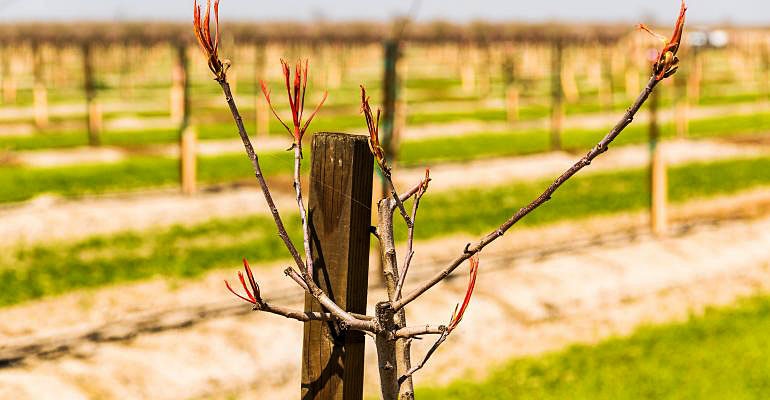
As growers attend meetings this week to learn how to access federal relief for lost pistachio trees due to bushy top syndrome, researchers say there are measures farms can take to curb spread of the disease.
Among the measures offered by the California Pistachio Research Board are (1) disinfecting tools such as budding knives, pruning shears, and shovels before using them in unaffected areas; (2) carefully surveying affected areas and removing infected plants; and (3) being cautious about how they replant.
WHAT IS BUSHY TOP?
Pistachio bushy top syndrome, or PBTS, is a relatively new disease that has emerged in California, Arizona, and New Mexico in recent years, affecting UCB1 rootstocks.
In 2014, a team of scientists posited that PBTS is caused by the bacterium, Rhodococcus fascians (Rf). Two pathogenic strains of Rf were identified, and they act synergistically to cause more serious disease symptoms, the scientists argued. Pistachio growers in California were urged to test for the pathogen in their newly-planted orchards.
More recent research from Oregon State University suggests that some Rf bacteria are beneficial to plants and that infections aren't caused by Rf itself but by a genetic mutation, sparking debate within the scientific community as to the exact cause of bushy top and how it is spread.
The percentage of rootstocks exhibiting symptoms varies widely among plantings. The most common symptoms are a consistent shortening of the internodes ,which leads to a bushy appearance of the rootstock, the CPRB says. The shortened internodes also result in stunted plants, with leaves on affected rootstock likely being smaller and a bit darker, with perhaps some reddening.
TAKE OUT TREES
There’s no cure for the disease, so affected trees generally need to be taken out. An affected tree that grows to maturity won’t show a high level of productivity.
Scientists say at least 20,000 acres of pistachios in California have been affected by the virus. Bushy top syndrome has been partly responsible for slowing acreage expansion in some areas, along with rootstock availability and water supply issues, CPRB Manager Bob Klein said in a state of the industry address last winter.
Meetings were being held this week in Sacramento, Madera, Tulare, and Bakersfield to inform pistachio growers affected by PBTS about opportunities to apply for government assistance from the USDA Tree Assistance Program, as the spread of the disease has been designated a natural disaster.
DETECTION AND CONTROL
Since the level of infection can vary literally from leaf to leaf, diagnostic testing with plant samples isn’t reliable, Klein points out in a report on the ailment. Currently, the only method that’s fast enough is visual identification, which a grower can learn to do with the help of a county farm advisor or nursery vendor, he says.
Once the disease is detected, a grower has to decide whether to remove only infected trees or if it is widespread enough to remove all plants and start over. Oregon State's researchers caution that some trees have been removed unnecessarily, worsening economic losses. One determining factor in replanting is whether there is enough rootstock available, Klein says.
Infection can occur throughout the plant, including roots, so growers will need to get as much of the roots as possible when removing the plant. Also, growers are advised to keep the area weed-free so the disease doesn’t colonize weed roots.
Some growers have waited a few months, or even a year, before replanting in the same spot where trees were removed, Klein says. If an entire planting is taken out, a grower can put new trees in the rows between the two sites, although it would require moving stakes and irrigation lines, he notes.
To read Klein’s full report, visit https://bit.ly/2OVS1W4
About the Author(s)
You May Also Like






